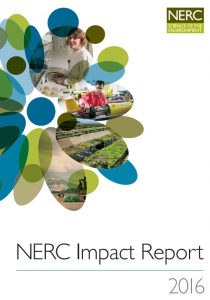By Phil Newton, Research Dean for the Environment Theme, University of Reading
‘Impact sometimes needs to be nurtured over long timescales… there is more to impact than developing case-studies for the next REF exercise’
The University of Reading is known across the world for the quality of its research in the environmental sciences. As Research Dean for the Environment Theme, I’m lucky enough to have the best seat in the house to see, up close, not just that quality, but also what a huge impact some of that research has on people’s lives.
 So it’s gratifying when others celebrate the influence of Reading’s research, as the Natural Environment Research Council (NERC) has done this week with the publication of its new annual report about the impact of NERC-funded research.
So it’s gratifying when others celebrate the influence of Reading’s research, as the Natural Environment Research Council (NERC) has done this week with the publication of its new annual report about the impact of NERC-funded research.
The NERC Impact Report 2016 shows how sustained NERC investment in environmental researchers working in partnership with the likes of governments, businesses and charities generates large, long-term economic and societal benefits – contributing to building a safer, healthier and more secure and sustainable world. It is great to see highlighted two areas of Reading research that are having substantial impact.
Reducing the tragedy of flooding
One is about the work of hydrologist Professor Hannah Cloke, and how the modelling and engagement work by Hannah and her colleagues over many years has improved the quality of flood forecasting, and changed the policy and practice of flood prevention, in the UK. These changes have been a major contribution to dramatic reductions in household flooding incidence over the past decade.
Such impact is hard won, and included Hannah taking a secondment to the Government Office for Science, and taking part in the Scientific Advisory Group for Emergencies that feeds into the Cabinet Office Briefing Room (the so-called ‘Cobra’) and ministerial decisions as flooding events loom and unfold.
Providing weather information to Africa
The second is a focus on TAMSAT (Tropical Applications of Meteorology using SATellite data), an system that uses models, satellite data and other observations to provide usable rainfall data, forecasts and related information to people in sub-Saharan Africa whose livelihoods depend not only rainfall variability, but who need early warnings of weather shocks such as flash floods and droughts.
Information provided by TAMSAT has demonstrably led to: improved responses by governments, agencies and charities through early warnings of crop failure (e.g. it helped 920,000 children receive food aid in the 2011-12 Sahel drought); more secure farmer livelihoods, by supporting commercial insurance against weather shocks for over 80,000 small-scale farmers in Kenya, Uganda and Zambia (many insurance companies are now involved); and more effective national weather services (e.g. a flash-flood warning system in Sudan).
Long-term impact
TAMSAT was established at Reading nearly 40 years ago, which illustrates the long timescales over which impact sometimes needs to be nurtured; this is of course well known, but it is a reminder to us all that there is more to impact than developing case-studies for the next REF exercise (important though that is). Emily Black and her colleagues here are now at the helm, striving to improve the quality and adoption of TAMSAT products, to achieve yet greater and wider impact.
My previous roles at Nature and at NERC brought me into contact with some of the top environmental scientists in the world. Many were, and still are, working at Reading, which is reflected by our success in attracting NERC funding. Last year, NERC provided about £12m to Reading. That’s more than a quarter of the University’s research income, across at least eight of our Research Divisions.
It’s an investment that is a vote of confidence in our excellent scientists, and which is really making a difference to people’s lives all over the world.
